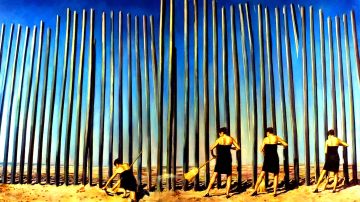Ana Teresa Fernandez Paints Away The U.S. – Mexico Border
In 2011, San Francisco artist Ana Teresa Fernández got dressed up in her “performance attire” (a tango-inspired black cocktail dress and heels), climbed up on a stepladder at the Tijuana–San Diego border, and proceeded—without a permit—to paint a section of the border fence blue so that it “disappeared” into the sky

Photo: Courtesy of Ana Teresa Fernandez
In 2011, San Francisco artist Ana Teresa Fernández got dressed up in her “performance attire” (a tango-inspired black cocktail dress and heels), climbed up on a stepladder at the Tijuana–San Diego border, and proceeded—without a permit—to paint a section of the border fence blue so that it “disappeared” into the sky.
Little did she imagine that five years later she’d be organizing community members, artists’ collectives, and border activists in three major cities to create the same piece on a mega-scale. In April 2016, Fernández led her latest version of Borrando la frontera in Mexicali, Agua Prieta, and Ciudad Juárez. Hundreds of participants painted out the jail-like bars so that the wall that Donald Trump wants to make bigger suddenly looked like it had holes in it that people could step through.
Born in Tampico, Tamaulipais, Fernández was ten years old when her family moved to San Diego. Legal border crossings to visit familia were a matter of fact. It wasn’t until she was working in restaurants while studying at the San Francisco Art Institute that she started to meet undocumented immigrant workers who had risked their lives to cross the border a different way. She became interested in the lives that society devalues, and the situations that aren’t discussed. In artwork that encompasses performance, painting, and video, she’s explored such subjects as the 2014 disappearance of 43 activist students in Ayotzinapa, Mexico, and the immigrants who use funky trunks to gather recyclable trash from the streets of San Francisco (Troka Troka).
For Borrando la frontera, Fernández has taken trompe l’oeil (“fool the eye”), a European art form that evolved for decorating the environments of the wealthy (think Versailles), and transformed it into a tool of resistance. We spoke with Fernández about people’s extreme reactions to her artwork, what motivates her, and the impact she hopes Erasing the Border will have.
Hip Latina: You’ve done all of your Borrando la frontera pieces from Mexico’s side of the border, starting with Tijuana in 2011. Why?
Ana Teresa Fernández: In Tijuana there’s only one beach, Playa, which everyone goes to, and that’s where the fence is. On the San Diego side, there are so many beaches, and that’s the only one that has no access by car for two miles. [The fence] just doesn’t exist in the [American] consciousness—in their visual landscape. On the Mexican side, they have to live, breathe, [and] see this thing every single day. It is like there’s this bleeding, huge beast that’s laying on the sand, very alive. And so for me that erasure had to happen for the Mexicans, for the people who actually have to live with it.
HL: How have people responded to the work?
ATF: People who live [in Tijuana] have come up to me afterward and said, “I’ve lived next to the fence ten years and never realized what it actually looked like until you painted a portion of it out.” They had gotten used to not seeing it anymore. “It made me actually see it for the first time and take into account what it means, that we have this thing on the beach that looks like jail bars.”
When I did it in Nogales [in 2015, during an artist’s residency at Arizona State University] it was like an explosion of reactions. Arizona runs at a very different temperature—either people react really positively or really negatively. So I had hate mail, people calling me “the Mexican Al Qaeda,” and people saying, “You’re going to die,” that I should be kicked out of the country. And then on the other hand I had people from all over the state inviting me to do the piece again.
HL: What do you think drives your work?
ATF: How do I bring someone to this information so they become intrigued by it and they are able to digest it—the heaviness—and then they’ll want to do something about it? I personally am not going to change policy; I’m not a politician. But I can raise awareness and instigate people’s imagination to want to believe something different than what they’re given. And I think that’s the most imperative thing: helping people imagine a different reality, a different truth.
HL: What has surprised you most about working on the border project?
ATF: The level of engagement I felt from people all over. I was like, “Really, you want to participate? Really, you want to travel from Arizona? Really, you want to risk getting arrested?” And then I finally got it. They have an active role in tearing down this wall, just through their imagination. That’s what people craved in Berlin. That’s what people crave now in Palestine. And in Mexico they want to really pare down that separation and have that sense of unity. By doing this action it allows their imagination to envision what that would be like.















